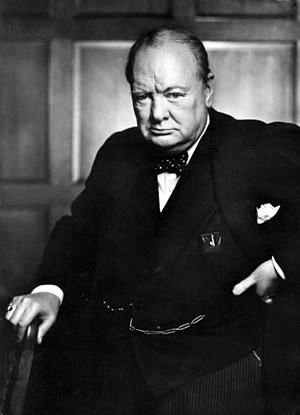CHURCHILL ADDRESSES CANADIAN LAWMAKERS
Ottawa, Canada • December 30, 1941
On December 28, 1941, British Prime Minister Winston Churchill left Washington’s Union Station, the capital’s major train station, for Canada. Six days earlier Churchill and his military and civilian advisers had arrived in the United States aboard the Royal Navy’s newly commissioned battleship, HMS Duke of York, to meet with their American and Canadian counterparts. The visit by the two heads of state and their entourage between Christmas and mid‑January 1942 was the first strategic conference Churchill and President Franklin D. Roosevelt had had since the Japanese surprise attack on U.S. military installations at Pearl Harbor, Hawaii, a little more than three weeks earlier.
The principal topics raised during December’s Arcadia Conference, also called the First Washington Conference, concerned the formation of a combined Allied command (ABDA, or American-British-Dutch-Australian), the inclusion of the Soviet Union in the Lend-Lease program passed earlier in April by the U.S. Congress, assistance to U.S. forces besieged by Japanese forces in the Philippines, placing U.S. personnel in the Danish possession of Iceland in the mid‑Atlantic and in Great Britain, and the wording of the United Nations Declaration, issued January 1, 1942, which was a pledge by 26 Allied countries to commit the bulk of their resources to subduing Nazi Germany first. The pledge followed on a decision by Roosevelt, Churchill, and their staffs to pursue a “Europe first” strategy in executing the war against the Axis. (In reality, the U.S. concentrated most of its resources to halting, then reversing Japanese advances in the Pacific, deploying 70 percent of the U.S. Navy and all the Marine Corps in the Pacific. Not until 1944 was the majority of U.S. resources directed toward defeating Germany.)
In the Canadian capital of Ottawa, Churchill addressed Parliament on this date, December 30, 1941, in a masterful performance similar to the one he gave before a joint session of the U.S. Congress several days earlier, except this time he spoke in English and French. Between passing from the Canadian House of Commons chamber to an anteroom, Churchill paused two minutes before the camera of an Armenian-born Canadian. Yousuf Karsh’s iconic “bulldog” photo of a scowling, belligerent, head-thrust-forward Churchill become one of the most memorable portrait images in history.
![]()
Winston Churchill’s Visit to the U.S. Congress and the Canadian Parliament, December 1941
 |
Above: Yousuf Karsh’s iconic portrait of Churchill appeared on the cover of Life Magazine on May 21, 1945, several weeks after the unconditional surrender of Nazi Germany to the Allies. The image of Churchill brought Karsh international prominence and is reputed to be the most reproduced photographic portrait in history. Nice work for a man who claimed he was filled with dread meeting Churchill, whose scowl deepened when the photographer dared to remove Churchill’s trademark cigar out of the great man’s mouth.
Churchill’s Address to a Joint Session of the U.S. Congress, December 26, 1941: “Now We Are the Masters of Our Fate”
![]()

 History buffs, there is good news! The Daily Chronicles of World War II is now available as an ebook for $4.99 on Amazon.com. Containing a year’s worth of dated entries from this website, the ebook brings the story of this tumultuous era to life in a compelling, authoritative, and succinct manner. Featuring inventive navigation aids, the ebook enables readers to instantly move forward or backward by month and date to different dated entries. Simple and elegant! Click
History buffs, there is good news! The Daily Chronicles of World War II is now available as an ebook for $4.99 on Amazon.com. Containing a year’s worth of dated entries from this website, the ebook brings the story of this tumultuous era to life in a compelling, authoritative, and succinct manner. Featuring inventive navigation aids, the ebook enables readers to instantly move forward or backward by month and date to different dated entries. Simple and elegant! Click 











